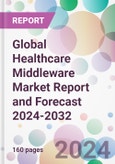Global Healthcare Middleware Market Outlook
The global health middleware market size was valued at USD 3 billion in 2023, driven by rising concerns over patient data privacy and the increasing incidence of cyberattacks across the globe. The market size is anticipated to grow at a CAGR of 9.7% during the forecast period of 2024-2032 to achieve a value of USD 6.9 billion by 2032.Health Middleware: Introduction
Healthcare middleware is a software layer that facilitates communication and data exchange between different healthcare systems and applications. It acts as a bridge, allowing disparate systems to interact seamlessly, ensuring interoperability, and improving the efficiency of healthcare operations. Middleware solutions standardize data formats, manage data transfer, and ensure secure and reliable communication, ultimately enhancing the integration of clinical, financial, and administrative information across the healthcare landscape.Key Trends in the Global Health Middleware Market
There's a growing emphasis on achieving interoperability among various healthcare IT systems. Middleware solutions are increasingly adopted to integrate disparate systems, ensuring seamless data exchange and communication across healthcare providers, payers, and patients.With rising concerns over patient data privacy and the increasing incidence of cyberattacks, the demand for middleware solutions that offer robust security features and compliance with healthcare regulations (like HIPAA in the U.S.) is on the rise.
The shift towards cloud-based middleware solutions is prominent, driven by the need for scalability, flexibility, and cost-efficiency. Cloud-based middleware allows healthcare organizations to manage large volumes of data and access advanced analytics and data processing capabilities.
The proliferation of mobile health apps and wearable devices has spurred the need for middleware solutions that can efficiently collect, analyze, and integrate patient-generated health data with traditional healthcare systems.
As healthcare organizations continue to focus on data-driven decision-making, there's a growing demand for middleware that can handle big data and provide advanced analytics capabilities. This includes predictive analytics to improve patient care and operational efficiency.
Middleware solutions are increasingly designed to support patient-centered care models, facilitating better patient engagement and personalized care by integrating patient portals, telemedicine, and remote monitoring systems.
Integration of AI and ML with middleware is a burgeoning trend, enhancing the capabilities of healthcare systems in terms of predictive analytics, personalized medicine, and operational efficiency.
Global Health Middleware Market Segmentation
Market Breakup by Type
- Integration Middleware
- Communication Middleware
- Platform Middleware
- Others Source
Market Breakup by Mode
- Cloud Based
- On-Premise
- Hybrid
Market Breakup by End User
- Hospital
- Clinics
- Ambulatory Surgical Centers
Market Breakup by Region
- North America
- Europe
- Asia Pacific
- Latin America
- Middle East and Africa
Global Health Middleware Market Overview
North America leads in healthcare middleware adoption, driven by advanced healthcare IT infrastructure, strong regulatory support for healthcare interoperability, and significant investments in digital health. The United States, in particular, shows a high adoption rate due to initiatives that encourage the use of electronic health records (EHRs) and health information exchanges (HIEs), fostering a conducive environment for middleware solutions.Europe shows a robust trend in healthcare middleware integration, supported by stringent data protection regulations like the GDPR, which emphasize secure data handling. Countries are increasingly focusing on improving healthcare interoperability and patient data access, leading to a growing demand for middleware solutions. The market is also influenced by various public health initiatives that aim to standardize healthcare data across the European Union.
The Asia-Pacific region is witnessing rapid growth in the healthcare middleware market, driven by increasing healthcare expenditure, digitalization of healthcare systems, and a growing emphasis on healthcare reforms. Countries like Japan, China, and India are heavily investing in healthcare IT infrastructure, though the region presents a diverse landscape with varying levels of technological adoption and healthcare infrastructure.
Global Health Middleware Market: Competitor Landscape
The key features of the market report include patent analysis, grants analysis, clinical trials analysis, funding and investment analysis, partnerships, and collaborations analysis by the leading key players. The major companies in the market are as follows:- Informatica
- Epic Systems Corporation
- Microsoft Corporation
- Fujitsu Ltd.
- Orion Healthcare
- International Business Machines Corporation
- Oracle Corporation
- InterSystems Corporation
- Abbott Laboratories (Alere)
- Siemens AG
This product will be delivered within 5-7 business days.
Table of Contents
1 Preface
3 Global Healthcare Middleware Market Overview
4 Global Healthcare Middleware Market Landscape
5 Global Healthcare Middleware Market Dynamics
6 Global Healthcare Middleware Market Segmentation
7 North America Healthcare Middleware Market
8 Europe Healthcare Middleware Market
9 Asia Pacific Healthcare Middleware Market
10 Latin America Health Middleware Market
11 Middle East and Africa Healthcare Middleware Market
12 Regulatory Framework
13 Patent Analysis
14 Grants Analysis
15 Funding and Investment Analysis
16 Partnership and Collaborations Analysis
17 Supplier Landscape
19 Company Competitiveness Analysis (Additional Insight)
20 Payment Methods (Additional Insight)
Companies Mentioned
- Informatica
- Epic Systems Corporation
- Microsoft Corporation
- Fujitsu Ltd.
- Orion Healthcare
- International Business Machines Corporation
- Oracle Corporation
- InterSystems Corporation
- Abbott Laboratories (Alere)
- Siemens AG
Methodology

LOADING...
Table Information
| Report Attribute | Details |
|---|---|
| No. of Pages | 160 |
| Published | February 2024 |
| Forecast Period | 2024 - 2032 |
| Estimated Market Value ( USD | $ 3.3 Billion |
| Forecasted Market Value ( USD | $ 6.9 Billion |
| Compound Annual Growth Rate | 9.7% |
| Regions Covered | Global |
| No. of Companies Mentioned | 10 |









